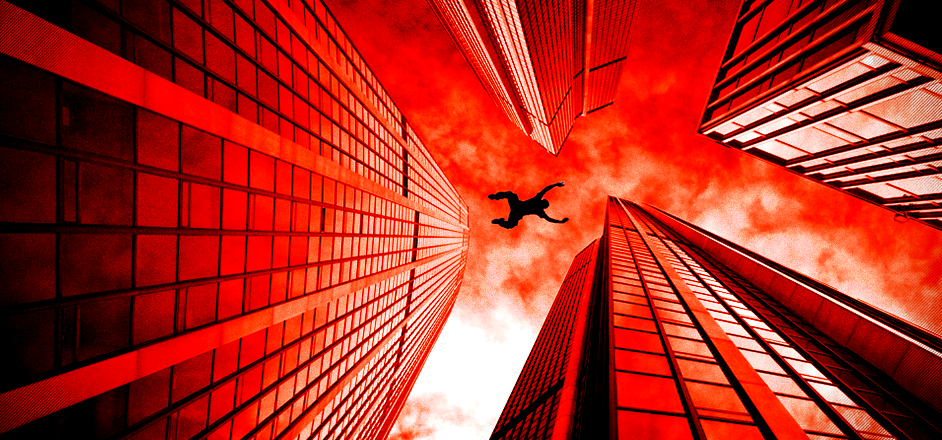“I definitely consider myself an adrenaline addict,” Chase Reinford says over the phone. Reinford even has a YouTube channel entitled “Adrenaline Addiction,” featuring videos of him leaping off massive cliffs and buildings.
“I get something very similar to withdrawals if I go a few days without my adrenaline-filled activities,” he admits. That might explain why Reinford continues his hazardous lifestyle even after several near-death experiences.
On one occasion, a competitive snowboarding accident ended in so many shattered bones that doctors nearly amputated his leg. In another snowboarding disaster, he flew off a giant cliff and tumbled over jagged rocks. Cliff jumps into water have left Reinford belly-flopping on impact, resulting in concussions and internal bleeding. Once, a parachute complication during a 1000-foot drop off a building’s antennae nearly ended in a splat.
Adrenaline addicts feed off the rush of feel-good chemicals released during life-threatening experiences. However, therapists say that adrenaline addicts aren’t just the lunatics jumping off cliffs and out of airplanes. As Dr. Marty Nemko, renowned counselor and career coach, tells us, tons of people seek out adrenaline rushes every day.
“I have a lot of adrenaline addicted clients,” Dr. Nemko says over the phone, “and it’s not something that necessarily needs to be cured. It all depends on how much they let their adrenaline rush determine what they do with their lives.”
In other words, adrenaline addiction works along a continuum. Some people get their euphoric high from fast-paced productivity. Some get theirs from plunging off bridges. Others get theirs from reckless driving, unprotected sex, and a baggie full of blow.
“Women going after bad boys is an adrenaline addiction. They want the dangerous man with the motorcycle, the tattoos and the drugs,” Dr. Nemko explains. “People drink until they get shitfaced. They take uppers, like cocaine, literally to get more adrenaline.”
These are extreme examples — people who fall on the high-end of the adrenaline addiction spectrum. These type of people, who gravitate toward new sensations, danger and risk, are commonly classified as “Type T” personalities.
Psychologist Dr. Frank Farley, who coined the term “Type T” after decades of studying extreme athletes and thrill-seekers, explained to the LA Times, “[These] people will tell you, when you’re at the edge of danger, that’s when you really feel life.”
Chase Reinford echoes this sentiment. “The biggest thrills come from activities with the biggest unknowns,” he says. “Doing something you’re unfamiliar with creates more fear. Once you do it successfully, it ends up being more rewarding.”
Some addicts can get their adrenaline fix in less extreme ways. They may use adrenaline to light a fire under their ass and motivate their daily activities. “Always overwhelmed, adrenaline junkies seem to have a constant need for urgency, even panic, to get them through the day,” author Patrick Lencioni writes in his article, “The Painful Reality of Adrenaline Addiction.”
While less hazardous than most extreme sports, “creating stress to get an adrenaline rush on a daily basis can still be dangerous,” Dr. Nemko says. “Some of these crazy people do it to the extent that it’s going to cause a heart attack.”
In any case, by the time you realize your adrenaline addiction could kill you, complete rehabilitation isn’t always an option. Dramatically changing your personality is difficult.
Exercise, yoga, meditation, and deep-breathing techniques are commonly suggested therapies. But Dr. Nemko finds those minimally effective. Instead, he focuses on “fine-tuning,” little efforts to reduce your adrenaline flow.
However, Dr. Nemko insists, it’s important to reiterate that adrenaline addiction doesn’t always require rehabilitation. “Being adrenaline-driven rather than addicted can be a plus,” he says. “These people can be incredibly productive. And in the social realm, other people are attracted to them. When you’re around a high-energy person, that energy is infectious.”
Reinford agrees, “Adrenaline-junkies in general are very passionate, ambitious people.” That’s why despite his multiple near-death experiences, Reinford ultimately sees his adrenaline addiction as a positive quality.
“Sometimes, after a bad accident or just before I’m about to jump, I ask myself, ‘why do I do this? Why do I put myself in this situation?’” Reinford reflects. “But as soon as you leave the cliff, you get this overwhelming feeling of peace. It immediately answers any questions of why you do it.”
Everybody’s gotta get their kicks somehow. Compared to alternatives like cigarettes, painkillers, cocaine, heroin, alcohol, sex and gambling, adrenaline may be the best addiction of the bunch.




Leave a Reply